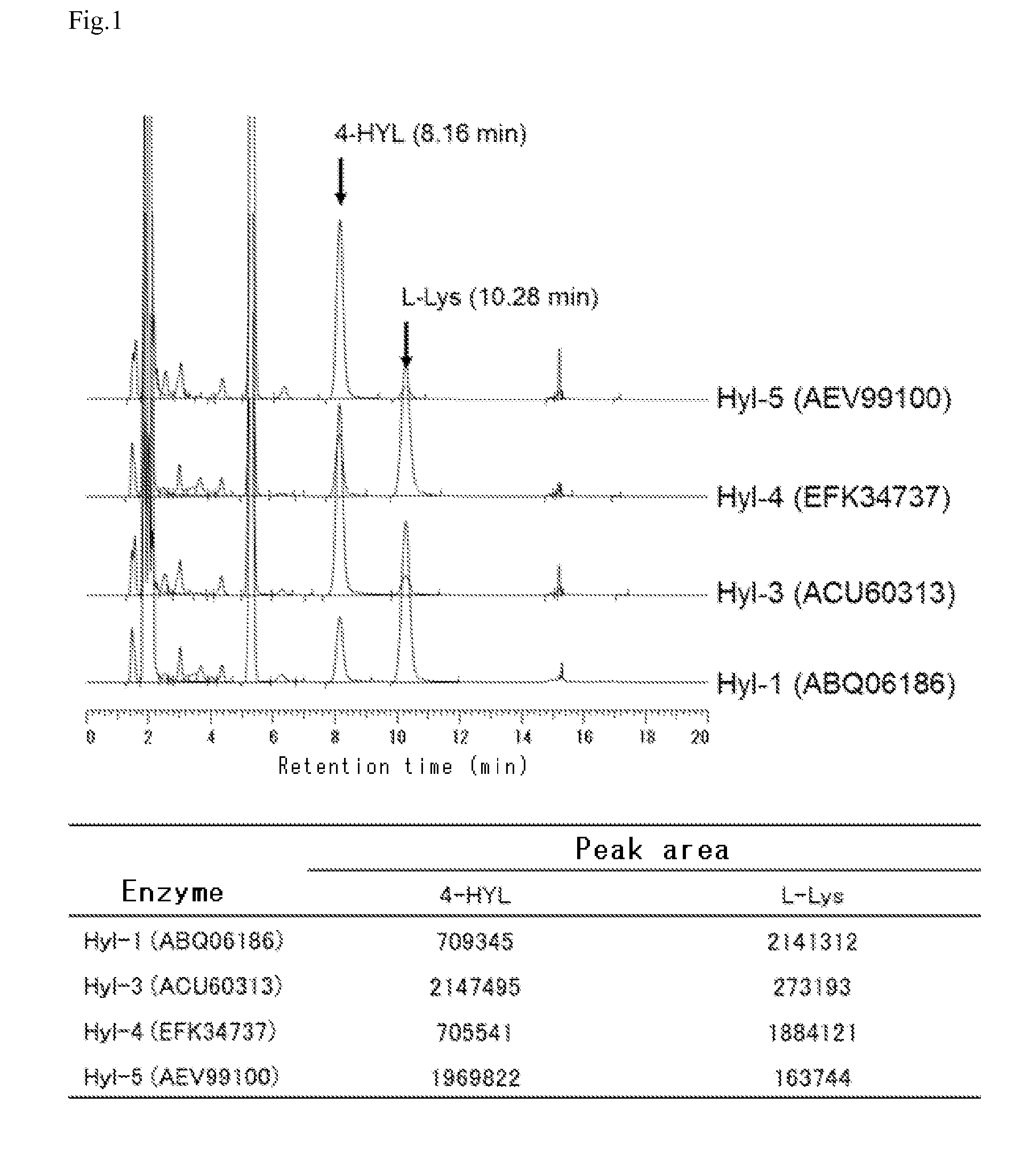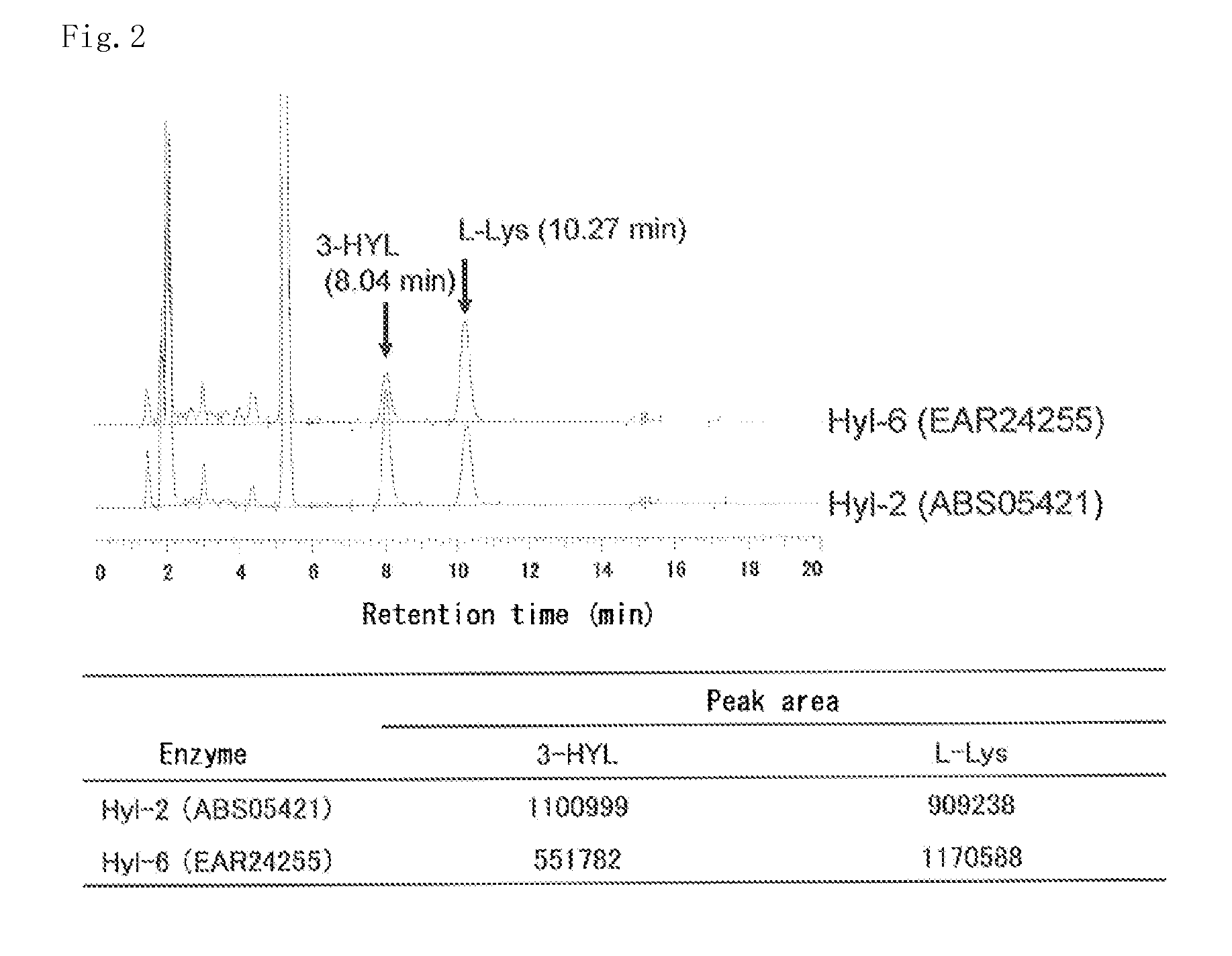L-lysine hydroxylase and production method for hydroxy-L-lysine and hydroxy-L-pipecolic acid using same
a technology of hydroxyl-lysine and hydroxyl-pipecolic acid, which is applied in the direction of enzymology, biochemistry apparatus and processes, chemical production of bulk materials, etc., can solve the problems of l-lysine enzymology that has not yet been reported, and achieve the effect of efficient production
- Summary
- Abstract
- Description
- Claims
- Application Information
AI Technical Summary
Benefits of technology
Problems solved by technology
Method used
Image
Examples
example 1
Cloning of 2-oxoglutarate-dependent L-lysine Hydroxylase Gene
[0183]Based on a gene sequence (hyl-1, SEQ ID NO:1) encoding an L-arginine-β hydroxylase VioC homologue Hyl-1 derived from the Flavobacterium johnsoniae NBRC14942 strain (GenBank Accession No. ABQ06186, SEQ ID NO:2), primers for amplifying the full-length sequence of the hyl-1 gene, hyl1_F (SEQ ID NO:13) and hyl1_R (SEQ ID NO:14), were designed and synthesized. Using chromosomal DNA of Flavobacterium johnsoniae as a template, PCR was carried out according to a conventional method, to obtain a DNA fragment of about 1.0 kbp.
[0184]In addition, VioC homologues derived from the Kineococcus radiotolerans NBRC101839 strain, Chitinophaga pinensis NBRC15968 strain, Chryseobacterium gleum NBRC15054 strain, and Niastella koreensis NBRC106392 strain were designated Hyl-2 (GenBank Accession No. ABS05421, SEQ ID NO:4), Hyl-3 (GenBank Accession No. ACU60313, SEQ ID NO:6), Hyl-4 (GenBank Accession No. EFK34737, SEQ ID NO:8), and Hyl-5 (Ge...
example 2
Confirmation of 2-Oxoglutarate-Dependent L-Lysine Hydroxylase Activity by Resting-Cell Reaction
[0188]In a plastic tube, 5 mM L-lysine, 10 mM 2-oxoglutaric acid, 1 mM L-ascorbic acid, 0.1 mM iron sulfate, and recombinant E. coli obtained by the method according to Example 1 were mixed to provide a reaction mixture such that the turbidity OD600 was 10. The reaction was allowed to proceed in 0.5 ml of the prepared mixture at 30° C. at pH 7.0 for 3 hours. The reaction product was derivatized with 1-fluoro-2,4-dinitrophenyl-5-L-alaninamide (FDAA), and then analyzed by HPLC. As a result, as shown in FIG. 1 and FIG. 2, it could be confirmed that BL21(DE3) / pEHYL2 and BL21(DE3) / pJHYL6 produced a compound corresponding to the retention time of a standard product of 3-hydroxylysine, 8.04 minutes. It could also be confirmed that BL21(DE3) / pEHYL1, BL21(DE3) / pEHYL3, BL21(DE3) / pEHYL4, and BL21(DE3) / pEHYL5 produced a compound corresponding to the retention time of a standard product of 4-hydroxylys...
example 3
Synthesis of (2S,3S)-3-Hydroxylysine
[0191]In a 1-L jar fermenter, 35 mL of 1 M potassium phosphate buffer (pH 7.0), 304 mL of desalted water, 1.28 g of L-lysine hydrochloride, 2.05 g of 2-oxoglutaric acid, 0.14 g of sodium L-ascorbate, 0.02 g of iron sulfate, 0.35 g of Adekanol LG109, and 8 g of wet cells of recombinant E. coli BL21(DE3) / pEHYL2 obtained by the method according to Example 1 were mixed together, and the reaction was allowed to proceed at 30° C., pH 7.0, a stirring rate of 500 rpm, and an aeration rate of 2.0 vvm for 17 hours. Completion of the reaction was judged by confirming disappearance of the peak for L-lysine by HPLC analysis. From the liquid after the completion of the reaction, bacterial cells and bacterial debris were removed by centrifugation and microfiltration, to obtain 390 g of a filtrate.
[0192]The conditions for analyzing the L-lysine by HPLC were as follows.
[0193]Column, SUMICHIRAL OA-6100 (4.6 mm×250 mm), manufactured by Sumika Chemical Analysis Servi...
PUM
 Login to View More
Login to View More Abstract
Description
Claims
Application Information
 Login to View More
Login to View More - R&D
- Intellectual Property
- Life Sciences
- Materials
- Tech Scout
- Unparalleled Data Quality
- Higher Quality Content
- 60% Fewer Hallucinations
Browse by: Latest US Patents, China's latest patents, Technical Efficacy Thesaurus, Application Domain, Technology Topic, Popular Technical Reports.
© 2025 PatSnap. All rights reserved.Legal|Privacy policy|Modern Slavery Act Transparency Statement|Sitemap|About US| Contact US: help@patsnap.com



